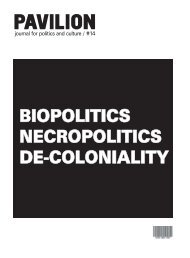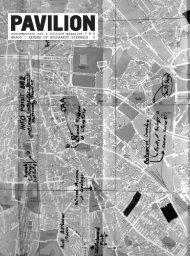Download pdf version of issue no. 16 (4 Mb) - Pavilion
Download pdf version of issue no. 16 (4 Mb) - Pavilion
Download pdf version of issue no. 16 (4 Mb) - Pavilion
You also want an ePaper? Increase the reach of your titles
YUMPU automatically turns print PDFs into web optimized ePapers that Google loves.
fixed or stabile: such relations must be<br />
constantly (re)negotiated, and conceived<br />
in <strong>no</strong>tions <strong>of</strong> publics or public spheres.<br />
This means, on the one hand, that the<br />
artwork itself (in an expanded sense), is<br />
unhinged from its traditional forms (as<br />
material) and contexts (galleries, museums<br />
etc.), and on the other hand, is made<br />
contingent on a(<strong>no</strong>ther) set <strong>of</strong> parameters<br />
that can be described as spaces <strong>of</strong> experience,<br />
that is, <strong>no</strong>tions <strong>of</strong> spectatorship<br />
and the establishment <strong>of</strong> communicative<br />
platforms and/or networks in or around<br />
the artwork that are contingent on, and<br />
changing according to different points <strong>of</strong><br />
departure in terms <strong>of</strong> spectatorship. The<br />
gaze <strong>of</strong> the spectator is, <strong>of</strong> course, <strong>no</strong>t<br />
only dependent on the work and its placement,<br />
but also on the placement <strong>of</strong> the<br />
spectator socially (in terms <strong>of</strong> age, class,<br />
ethnic background, gender, politics etc.).<br />
Or, more broadly speaking, experiences<br />
and intentionalities. In turn, work, context<br />
and spectator influence the definition <strong>of</strong><br />
each other. None <strong>of</strong> which are given, and<br />
each <strong>of</strong> which are potentially conflictual,<br />
indeed agonistic: One may or may <strong>no</strong>t<br />
feel addressed, may or may <strong>no</strong>t accept<br />
the mode <strong>of</strong> address, even, by a given<br />
work or a given situation (both artwise<br />
and socio-politically). When thinking<br />
about art production and representation,<br />
it is therefore crucial to negotiate these<br />
terms both individually and in relation to<br />
each other. We must, then, think <strong>of</strong> art in<br />
terms <strong>of</strong> a triadic model, rather than in<br />
terms <strong>of</strong> dialectics (such as form and content,<br />
tradition and desire, meaning and<br />
<strong>no</strong>n-meaning, and so on). To the extent<br />
that such a model was presaged by parts<br />
<strong>of</strong> historical conceptualism, we are as<br />
much within an post-conceptual as postmodern<br />
era.<br />
[80]<br />
A contemporary investigation <strong>of</strong> how art<br />
and artists are produced must thus<br />
reconfigure the terms <strong>of</strong> theory and practice<br />
in a different way, and explore both<br />
what can be termed the practice <strong>of</strong> theory<br />
and the theories <strong>of</strong> practice (historical<br />
and current): What exactly is involved in<br />
an act <strong>of</strong> representation? What is, for<br />
instance, the relationship between artistic<br />
practice and political representation, that<br />
is, two different <strong>no</strong>tions <strong>of</strong> representation?<br />
What are the possible positions<br />
within the artistic field for political representations<br />
and perhaps even actions,<br />
and which modes are productive and<br />
which counter-productive? And, furthermore,<br />
what is the relationship between<br />
the claimed auto<strong>no</strong>my <strong>of</strong> the artwork, and<br />
claims for political auto<strong>no</strong>my? But also:<br />
what is the relationship between representation<br />
and depresentation?.[5] What<br />
are the correlations between strategies<br />
and formal expressions? What are, for<br />
example, the trappings and potentials <strong>of</strong><br />
collective works and groupings compared<br />
to the role <strong>of</strong> the singular artist? How do<br />
you define your work vis-à-vis the apparatus<br />
surrounding art production and<br />
presentation? What is the public role <strong>of</strong><br />
the artist, historically, presently and<br />
potentially? These discussions must<br />
revolve around the various tools and<br />
methods <strong>of</strong> representation available to<br />
us: how we can conceive <strong>of</strong> var-ious<br />
modes <strong>of</strong> address, and how new narratives,<br />
and in turn subjectivities, can be<br />
constructed? This is also an adequate<br />
moment to repeat the classical question:<br />
To and for whom do we speak? And what<br />
are the differences in our conceptions<br />
and invocations <strong>of</strong> various <strong>no</strong>tions <strong>of</strong><br />
institutions, audiences, constituencies<br />
and communities?<br />
If we look at the academy itself we have<br />
been handed down certain historical<br />
models, the idea <strong>of</strong> "free art” and the<br />
master class, namely one pr<strong>of</strong>essor talking<br />
to multiple students and deciding<br />
what art education is. In terms <strong>of</strong> mode <strong>of</strong><br />
address this is, <strong>of</strong> course, a pre-democratic<br />
model, a <strong>no</strong>n-dialogical mode <strong>of</strong><br />
address, based on the sovereign reigning<br />
his subjects, listening attentively to his<br />
master’s voice (an inherently hierarchical<br />
and masculinist subject positioning).<br />
However, if artists are <strong>no</strong>w to be engaged<br />
with the world and <strong>no</strong>t just themselves<br />
and their desirous relationship to a tradition<br />
- which was, famously, Norman<br />
Bryson’s definition <strong>of</strong> academism in classical<br />
art - we must question the relevance<br />
<strong>of</strong> this model and perhaps look more<br />
closely at the university model <strong>of</strong> several<br />
lecturers and certain curricula as instigated<br />
by the Bologna process. If we view the<br />
academy as a "teaching machine”, to paraphrase<br />
Gayatri Spivak, we must ask,<br />
then, what kind <strong>of</strong> subjects (i. e. the students)<br />
and what kind <strong>of</strong> k<strong>no</strong>wledge (i. e.<br />
the teaching) is produced. Presently, this<br />
has a heightened urgency, since we are<br />
importing the Anglo-American university<br />
system onto the traditional European<br />
academy model. It would be illusory to<br />
think that the implementation <strong>of</strong> a modular<br />
system will in itself solve the problems<br />
and grievances we have with the historical<br />
master class. One will merely substitute<br />
a system <strong>of</strong> discipline with a system<br />
<strong>of</strong> control: whereas the traditional educational<br />
system is part <strong>of</strong> the disciplinary<br />
society, the new methods <strong>of</strong> examination,<br />
modules and internalization, can be seen<br />
as part <strong>of</strong> a society <strong>of</strong> control. Power is <strong>no</strong><br />
longer exercised through discipline, as it<br />
is very concretely in the traditional academy<br />
with its disciplinarily themed depart-<br />
ments and sovereign pr<strong>of</strong>essors, but<br />
rather through a simultaneous diffusion <strong>of</strong><br />
this power, making it less visible and personally<br />
identifiable, but double enforceable<br />
through various mechanisms <strong>of</strong> control<br />
and (self)surveillance, where you<br />
individually have to choose your course<br />
work, but according to a modular system<br />
installed in advance, and with various<br />
instances <strong>of</strong> evaluation and examination.<br />
This "educational system” <strong>of</strong> control is<br />
continued after graduation, <strong>of</strong> course,<br />
through how your work processes and<br />
advance in the artworld, or generalized<br />
field <strong>of</strong> cultural production, is structured.[6]<br />
In this sense, the <strong>no</strong>tion <strong>of</strong> the cultural<br />
producer, a contemporary artist figure,<br />
can be seen as complicit with these later<br />
developments within administration, politics<br />
and capital. The artists are a sort <strong>of</strong><br />
social avant-garde, on the forefront <strong>of</strong> the<br />
risk society and the <strong>no</strong>tion <strong>of</strong> immaterial<br />
laborers. As producers <strong>of</strong> k<strong>no</strong>wledge universities<br />
are <strong>of</strong>ten mere teaching<br />
machines, reproducers rather than producers<br />
<strong>of</strong> k<strong>no</strong>wledge and thinking, which<br />
is why we should <strong>no</strong>t uncritically adopt<br />
their structures. Rather, one should learn<br />
from those structures as spaces <strong>of</strong> experience,<br />
as discursive spaces, and simultaneously<br />
to the implementation <strong>of</strong> its<br />
productive features, maintain the <strong>no</strong>tion<br />
<strong>of</strong> unproductive time and space, which<br />
was potentially hidden in the academy<br />
model: where the traditional pr<strong>of</strong>essorial<br />
reign meant that the pr<strong>of</strong>essor in charge<br />
decided on methods and curricula (if<br />
any), he or she could naturally also allow<br />
for the students to do whatever they<br />
wanted, even doing <strong>no</strong>thing. Such is the<br />
total power <strong>of</strong> the sovereign: to be a good<br />
king or a bad king … Reversely, the stu-<br />
[81]








